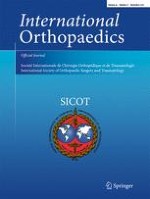Erschienen in:

25.08.2017 | Original Paper
Results of lateral ankle ligament repair surgery in one hundred and nineteen patients: do surgical method and arthroscopy timing matter?
verfasst von:
Ibukunoluwa Araoye, Cesar De Cesar Netto, Brent Cone, Parke Hudson, Bahman Sahranavard, Ashish Shah
Erschienen in:
International Orthopaedics
|
Ausgabe 11/2017
Einloggen, um Zugang zu erhalten
Abstract
Purpose
Ankle sprains are the most common athletic injury. One of five chronic lateral ankle instability patients will require surgery, making operative outcomes crucial. The purpose of this study is to determine if operative method influences failure and complication rates in chronic lateral ankle ligament repair surgery.
Methods
We retrospectively reviewed 119 cases (118 patients) of lateral ankle ligament surgery between 2006 and 2016. Patient charts and operative reports were examined for demographics, use and timing of ankle arthroscopy, ligament fixation method, type of surgical incision, presence of calcaneofibular ligament repair, and operative technique. Impact of operative methods on failure (one-year minimum follow-up) and complication outcomes was explored using Chi-square test of independence (or Fisher’s exact test). Statistical significance was set at p less than .05.
Results
Mean age at surgery was 40 (range, 18-73) years. Mean follow-up was 51 (range, 12-260) weeks. Failure rate was 8.4% (10/89 cases) while complication rate was 17.6% (21/119). Failure rate did not differ significantly between any data subgroups (p > .05). Single stage arthroscopy was associated with a significantly lower complication rate (11%, 4/37) than double-stage arthroscopy (47%, 9/19) (p < .01) as was suture anchor ligament fixation (9%, 6/67) compared to direct suture ligament fixation (29%, 15/52) (p < .01).
Conclusion
Failure rate was not impacted by any of the studied variables. Use of suture anchors and concurrent ankle arthroscopy may be favourable options to achieve fewer complications in chronic lateral ankle instability repair surgery.











